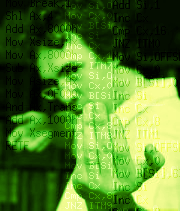Vous vous souvenez peut-être du bashing du Fantasia d'Infogrames par le joueur du grenier. Moi oui. C'est devenu une de mes contre-références. Comment un tel jeu a-t-il pu recevoir le "seal of quality" malgré son horrible gameplay?
 Le contrôle de Mickey est absolument insupportable. C'est L.O.U.R.D. [...] On aurait fait un jeu avec [un président de France gras] qu'il aurait été plus agile!
Le contrôle de Mickey est absolument insupportable. C'est L.O.U.R.D. [...] On aurait fait un jeu avec [un président de France gras] qu'il aurait été plus agile!
Quand vous vous tournez, Mickey a une espèce d'inertie hyper-chiante. [...] C'est pareil pour les sauts. [...] Ils ont niqué le gameplay, mais l'important c'est que la souris magicienne qui parle, là, elle saute de manière réaliste. [...] Ce temps de latence absolument dégueulasse **ruine**le**jeu**: le moindre saut devient incalculable. [si vous ratez votre coup en voulant sauter sur un ennemi], vous ne pouvez pas réessayer parce que votre personnage est obligé de prendre de l'élan et donc il reste figé une demi-seconde pour sauter.
Maybe you don't speak French at all, in which case it might help you to know that the guy in the yellow shirt above is known as "le Joueur du Grenier" -- which more or less translates as "the gamer in the attic", who does retro game coverage with a "angry VG nerd" inspiration and a French touch. When he bash a game such as Infogrames' Fantasia on the Mega Drive, he insists so much on things such as "don't put huge things in the foreground", that I cannot ignore them. Some features of Bilou: School Rush have been dismissed because I believe Grenier would bash them if he ever played the game.
J'ai trouvé quelques éléments de réponse dans
la dernière vidéo de Splashwave qui couvre la série "* of Illusion" et Fantasia. Sega avait réussi à obtenir le droit d'adapter les personnages Disney sur leur console et s'étaient retrouvé après un Castle of Illusions qui avait besoin d'une suite et un Disney qui voulait un jeu-promo sur Fantasia pour accompagner à Noël sa ré-édition.
Another major flaw he points in Fantasia is the stiffness of the character moves and the lack of consistence in the game rules -- such has having a huge flapping book as a bonus and a small circle in the water being actually ground to stand on. To the point where I started wondering how such a bad game could have ever received the "seal of quality" required to be published on a 16-bit machine.

L'enquête splashwave révèle aussi que le développement de Fantasia s'est énormément concentré sur les graphismes, ce qui ne devrait pas surprendre vu l'importance que la firme attache à la fidélité de représentation de sa mascotte. Les designers détachés par Disney auprès des équipes de jeu ne sont sans doute pas des joueurs à cette époque. Il est probable qu'ils n'auront jamais pris la manette en main pour regarder les prototypes, mais ils seront intraîtables sur des oreilles trop grandes ou des pieds trop petits.
Then came the amazing video in the "Splash Wave" series on the making of Castle/World of illusion and Fantasia games. Both had the same Disney supervision and were part of a licensing deal directly managed by Sega. In all of them, Disney representatives were super-strict on look and behaviour of their characters, to the point where "lives" are dubbed "tries" because Mickey cannot die nor kill. And you should better not have their ears a bit too large or feets a tad too ocre.
Splashwave's investigation reports how the Infogrames team spent almost all of their time polishing graphics and kept the gameplay development at the end of the planning. It strongly shows for the CES demo, where most visuals are complete, but the goals are unclear and the controls are a nightmare. How could that have happened ? Who could lead game development at professional scale and do such a thing ?
Au moment de présenter une démo du salon CES, tout le monde est impressionné par les graphismes, mais il y a encore énormément de travail à faire sur le gameplay: Infogrames avait prévu de s'y attaquer
sur la fin du développement. Après la lecture des
habitudes de travail de Miyamoto ("faites d'abord un test avec un carré/cube. ça doit être fun à jouer rien qu'avec un cube") et les vidéos des t
ravaux préparatoires de Ori and the Blind Forest, j'en arrivais à me demander "mais quel chef de projet peut laisser le travail avancer autant sans jamais travailler sur le gameplay ?"
Quelques heures plus tard, je retombe par hasard sur une
vidéo du prototype de Rayman sur SuperNES et j'ai la réponse: quelqu'un qui est avant tout un graphiste.
L'important pour lui ce ne sont pas les mécanismes de jeu. Ce n'est même pas l'histoire qu'il veut raconter. C'est l'environnement dans lequel le jeu va jouer. Le monde magique qu'il veut sortir de sa tête. Si on le laisse faire, tout son temps va être consacré à dessiner, s'assurer qu'il peut faire tenir ses dessins dans la mémoire de la machine, essayer des effets de transparence, etc. Le déplacement du personnage sera simplifié au point d'être essentiellement un testeur d'animations.
Watching a video of the Rayman-on-SNES prototype suddenly revealed a possible answer to the question above. Because we are almost exactly there with this wannabe-title too. The visuals are stunning, even if totally unrelated of the dreams world of Rayman. They are not just nicely executed: we have all the slope effects and the animated backgrounds, and the variety. Everything. Rayman is walking along and jumping, but there is nothing we can really do but move forward. Nothing to bounce of. Nothing to punch out. Not even a ting to grab. I could easily see man-month effort in this demo, but yet there is not an ounce of gameplay.
Knowing that Michel Ancel is initially more a design-and-draw guy, I could say "that is the type of person who could spend so much time on the look before starting to work on the feel". That demo exactly show that. There is not a bouncing ball doing all amazing things in his head. There is not either a grand story to be told. But there is an amazing world of wonders that waits for being explored. Awe, not fun. And so, when ennemies are eventually introduced in such a demo, the purpose is more to check how their animation renders than trying to start interacting with them.
Soyons clair: sur SuperNES
pour quelque-chose de plus ambitieux que Mario World au niveau graphique, c'est déjà costaud. Le prototype de Michel Ancel est allé plus loin: il y a des tests de collisions et compagnie. Mais il n'y a rien à faire dans le jeu. Aucun ennemi. Le personnage est lourd à manoeuvrer et on ne sait même pas lancer son poing (juste accumuler de l'énergie pour le lancer plus loin). Pourtant l'environnement est déjà super-détaillé et très varié.
Mais en réécrivant la partie Anglaise de ce post je me rends compte d'un défaut dans mon raisonnement: il ne tient que si le prototype que l'on voit ici est la seule chose qui ait été produite jusque là. Or il est fort possible que des essais d'interaction avec les ennemis aient eu lieu sur une autre machine (sans doute un Atari ST ou un Amiga, à l'époque). Ce n'est pas le genre de code qui demande un expert sur une console 16-bit, alors que vérifier qu'on a assez de couches de graphisme pour faire ce qu'on veut, c'est beaucoup plus difficile à simuler.
Et il est aussi possible que ç'ait été une habitude dans le milieu du jeu vidéo Français: pour convaincre un éditeur potentiel, il aura fallu montrer des graphismes aboutis, peu importe le gameplay ou le nombre d'ennemis différents qu'on affronte. Hors de question en revanche que le personnage ne soit toujours qu'un cube qui se déforme un peu.
I might be wrong of course. First because the Rayman-on-SNES prototype might have been a companion for a gameplay-on-Amiga prototype that nobody ever thought to preserve. Second, because it might not be something linked to the mind of the designer, but rather to the habits of the video game business in France by that time. Maybe you'd be sure to see your budget cut if you dare to show a prototype with placeholder cubes and rectangles, and you're likely to get the project accepted by a potential editor if you have stunning visuals.
Oh, et pour les trivia, selon Splashwave, ce n'est pas parce que le jeu Fantasia était trop pourri que Sega l'a retiré des magasins, mais parce que les gars de chez Disney avaient oublié qu'ils avaient
promis à Walt qu'ils ne feraient pas de produits dérivés de son bébé chéri.



























 Vote for your favourite post
Vote for your favourite post

